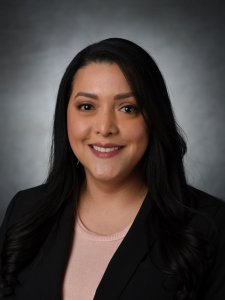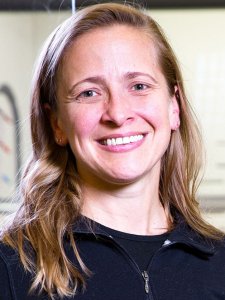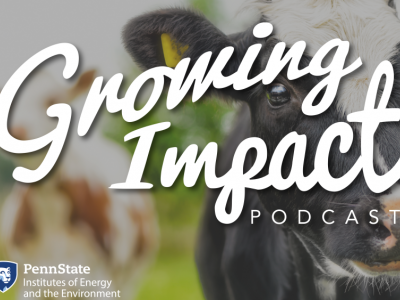The latest episode of the Growing Impact podcast features Juliana Vasco-Correa, an assistant professor of agricultural and biological engineering. She discusses her seed grant project that investigates how biofiltration could reduce greenhouse gas emissions, specifically methane and carbon dioxide.
Transcript
INTRO: We have to target all emissions to solve this problem of climate change. Super high-tech engineering solutions are really important, and they’re part of the portfolio of solutions that we're going to need. But solutions that are a little bit more simple, have more potential to be implemented fast and we need solutions fast for these problems.
HOST: Welcome to Growing Impact, a podcast by the Institutes of Energy and the Environment at Penn State. Growing Impact explores cutting-edge projects of researchers and scientists who are solving some of the world's most challenging energy and environmental issues. Each project has been funded through an innovative seed grant program that is facilitated through IEE. I'm your host, Kevin Sliman. On this episode of Growing Impact, I speak with Juliana Vasco-Correa, an assistant professor of agricultural and biological engineering at Penn State. Our conversation looks at her project titled “Methane Emissions Mitigation and Carbon Capture with Biofiltration.” What if the traditional method of eliminating methane, flaring, does not work? For airstreams that have a low percentage of methane, such as emissions from dairy barns, there needs to be another solution. Juliana describes how she and her colleagues are designing and building biofilters that can convert methane into carbon dioxide and then capture that CO2.
HOST: Thank you for being here and welcome to Growing Impact, Juliana.
Juliana Vasco-Correa (JV): Thank you very much, Kevin, for inviting me. I'm happy to be here.
HOST: Can you just provide an overview of the project and give us just a flavor of what it is that you're working on?
JV: Yes, absolutely. So what we're trying to develop is a biofilter for airstreams that have methane. Methane is a greenhouse gas that is very potent. So what we're trying to do is to use these biofilters, that are like these big columns packed with a support material and they have bacteria on it. And the bacteria are able to mitigate the methane, to basically eat the methane that is in the air and reduce the impact.
HOST: Let's discuss methane. Where is methane primarily coming from and how is it damaging?
JV: Methane is actually the second-largest contributor to climate change after carbon dioxide. And it comes mainly from what we call enteric emissions. So emissions from ruminants, from mostly cows and other animals like that, that produce it their stomachs because they have bacteria on it. So they have these certain bacteria that ferments the feed inside their stomach and produces methane. That's the main source, but actually even though it’s the main source, it's only about 17% of the total of methane emissions. And that's the key with methane that it is very distributed. It still comes from dams, from rice paddies, from leaks in pipelines, from coal mining. So it's very, very distributed. And it's very diluted. So most of the airstreams that are around that have methane, have a very low concentration of methane. So actually capturing and doing something practical with it is very difficult. So if the methane, for example, is at a concentration higher than 5%, we could just burn it, we could just flare it. And if we flare it, it is not an ideal solution. But it converts it from methane into carbon dioxide, which everyone would think, well, that's not good. Carbon dioxide is not good. But actually, methane has a global warming potential of all thirty-six times more than carbon dioxide. So it's way worse for the environment. So if we convert it into carbon dioxide, we’re able to reduce the impact on global warming by more than 30 times. So flaring works, but the problem is, most airstreams with methane have less than 5% methane concentration. And if it's that diluted, then it just doesn't burn. So we cannot flare it. So those are the streams that we're targeting, the ones that are very diluted, very distributed. And then we're thinking, well, those we can fix them with biofiltration.
HOST: Alright? And so we can't flare the methane that's coming out of cows, my guess is. I would think the cows probably would not appreciate that.
JV: They would not. But of course, we would not go directly to the cow, but take the air like for example out of a barn on a dairy farm. But that, if we tried to flare it, it will not burn. It is less than 1%.
HOST: Interesting. Okay. Even though cows account for a large amount, it's still a diluted, it would still be such a diluted amount that it wouldn’t work.
JV: Yes.
HOST: Are there emissions, are there other emissions that this project is focusing on? Are there any others that you're looking at?
JV: Yes. So precisely CO2. So what we're trying to do with this biofilter is something very similar to what will happen in flaring. It converts methane into CO2. But instead of doing it by combustion, like the flare because it just doesn't happen, the bacteria do it. So the bacteria are able to eat the methane, and then they produce carbon dioxide.
HOST: Let's actually talk about biofiltration and how it works.
JV: Biofiltration—what we're trying to do is to create these big biofilters that would be like these columns that are packed with a material where the bacteria grows, but also that it’s able to capture the carbon dioxide. We will take the air out of these places where there's the emissions, for example, a barn from a dairy farm, and then pass the air through the biofilter. And then the bacteria that is in this, a special kind of bacteria called the methanotrophs that are able to eat methane and produce CO2. And then hopefully the CO2 will get absorbed and captured inside of biofilter because of the material So the material is something very common. It will be at least a mixture of materials, mostly organic materials, compost. And we’re going to try some residues from the forestry industry like sawdust and then do some treatment to it so it can actually capture the carbon.
HOST: So when you look at your project, what are you hoping it will achieve?
JV: While this is a one-year project and in this short-term, what are we hoping is to develop a pilot system in the lab to be able to test some of our theories. So we are doing a lot of engineering design with our students, both in the systems and in the lab, and then all the controls that we can test a lot of our theory. And we're also focusing on two goals of the engineering of the biofilter—the microbes and the material. Still we're trying to engineer the microbial communities, the bacteria that is inside of the filter. There will be several types. And we're trying to engineer them in a way that their stable and they work together to achieve the maximum amount of methane oxidation or methane mitigation. So that is one goal. And the second one is the materials part that as I said, it's making these materials that are functional and are able to be a good support for the microbial communities, for the bacteria, but also capture carbon.
HOST: All right. This is exciting. It seems, it's such a… don't get me wrong. I'm sure the work behind the scenes in the lab and getting that all figured out. Don't get me wrong, I'm not trying to say that it's simple, or say “of course,” but it seems like a simple concept, right? It's filtration. We've been using filters, but this really cool idea of adding these microbes that can eat methane, and maybe then the material can actually capture the carbon. Yeah, I mean, it's, it's really cool.
JV: I think if it's simple, it’s more likely to work. I find that if the compliment if you think it’s simple. I do think for a solution like this, when we're talking about emissions that are quite diluted… We have to target all emissions to solve this problem of climate change. Super high-tech engineering solutions are really important, and they’re part of the portfolio of solutions that we're going to need. But solutions that are a little bit more simple, have more potential to be implemented fast and we need solutions fast for these problems. I think that's how I see it and for a simple solution like this.
HOST: Well, that's really well put, and I appreciate that perspective. You're talking about your lab and you're going to have students and others helping. Could you talk about how a project like this would benefit from or does benefit from an interdisciplinary team?
JV: We do have a fantastic interdisciplinary team and have been working on this project for some months now. I'm a bioprocess engineer. And, and that is the main goal of this project, so that's why I'm leading the team. But we also work with other two professors, Dr. Mary Ann Bruns, and she’s a soil microbiologist. She's helping us with all the microbial parts, trying to figure out how to get the best microbial community composition in a natural way. A super sophisticated synthetic biology way, which would be great, but maybe not so stable, but in a more natural way, trying to use the natural systems and develop microbial community out of what already exists in nature. And then Dr. Lauren Greenlee from chemical engineering, that is helping us with the functionalizing of the materials. She knows a lot about these materials, and she had the idea of carbon capture as part of the biofilters as well. And we've been working with a group of students from different disciplines, from biological engineering to biorenewable systems, and actually also a student from engineering design helping us actually design and build the biofilter.
HOST: Do you have any next steps or future plans that you can talk about at this point?
JV: We have been thinking on another and it is actually related to one of the questions to ask about other emissions. We've been thinking about the third main emission from greenhouse gases, that is nitrous oxide. So actually from emissions from agriculture, nitrous oxide tends to be the most important one. So nitrous oxide is way more potent than even methane. It is about 300 times more potent in global warming potential than CO2. And the thing is, most people that are, that have tried to study biofilters, have not measured nitrous oxide at all. And what we think is there might be a risk that under some conditions in these biofilters, they might be the production of nitrous oxide. And if that happens, all the benefits that we will have will just get eliminated. Because even if we produce just a little bit of this gas, since it's so potent, it would be a big problem. But I also think that there's the possibility that if there's a little bit of nitrous oxide coming in the end stream, going into the biofilter like for example, coming from a barn, that it actually could be also mitigated. Still, we want our next step after we figured out the basis of the biofilters, is to figure out more detailed dynamics of all these other greenhouse gases and when would they be produced for us to then try to avoid those conditions and if we can mitigate those, are there additional greenhouse gases.
HOST: Juliana, thank you so much for coming on the podcast and sharing about your project.
JV: Well, thank you very much for inviting me. It was a pleasure. And hopefully people are interested in our project and if anyone wants to collaborate with us, we'd be happy to hear from you.
HOST: You've been listening to Growing Impact, a podcast by the Institutes of Energy and the Environment at Penn State, I've been your host, Kevin Sliman. This has been season two, episode 5. Thank you for listening.










